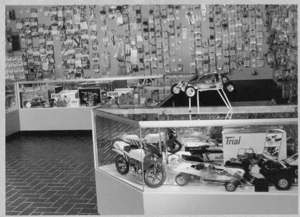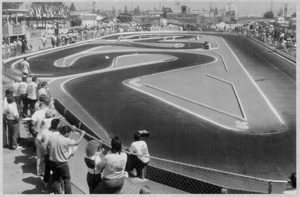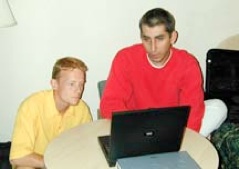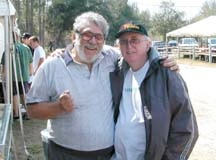






















*Source for the following information is from 2013 and 2017 recorded discussions with Gil Losi Sr, Gil Losi Jr and Janet Losi.
The following was written more as list of historical facts and less a story. It may come off a little disjointed because of this writing style.
Before Team Losi
Before Gil Losi Sr started Team Losi he started a skateboard company called Veriflex with a brother and nephew. They decided to start it while talking at a family wedding.
Gil Jr and his brother did a lot of skateboard competitions. Then a skatepark near Veriflex put in a track for RC. One day Gil Sr brought home some Tamiya kits and Jr put them together and started racing. Shortly after this Jr did his last skateboard tour around 1978 or 1979. Gil Jr despised skateboarders and the industry. People had to be a hoodlum and drug users to be popular and he didn't want to be part of that group. The last big group he was with trashed a Dennys after a competition. He just didn't want to have anything to do with the people. RC was less profitable but he enjoyed it a lot more than the skate scene. Gil Sr built a RC track next to a skate park they owned and soon they started running races. The city eventually shut them down for lack of permit and insurance.
Gil Sr then decided to buy the Ranch Pit Shop because it was pretty much bankrupt. There was two partners that owned the Pit Shop. One was trying to rip them off while the other was trying to tell them they shouldn't buy the place because they would lose their shirts. Pit Shop had a mail order business, Sr continued running that and soon became the equivalent of AMAIN Hobbies today. Then they grew the mail order business into an importer and distributor business. Sold and imported Yokomo, Kyosho, and Cox kits. They would actually countersink the fiberglass chassis for Yokomo kits when they came in to be repacked in US. Pit Shop also imported the Serpent 8th scale on-road kit. They made conversion kits and got so successful it drove Team Associated out of 8th scale on-road market.
Team Losi Begins
Team Losi got its start in the early 80s making pinions and spur gears and sold them through the Pit Shop. They also made nerf bars for Tamiya cars. A lot of the parts were handmade in the shop. Later they started making hop-up parts for Yokomo and Team Associated kits,
During this time Jr was racing RC and was asked to help develop the Team Associated RC12L, L stands for Losi.
They made a lot of money selling off-road and then Team Associated came to them and said they wanted to make an off-road car. Team Associated asked Gil Jr to help design. For his help they made a deal for 10% discount and the first year they would be allocated three thousand kits. Jr hated the final transmission that was released but it was still better than a lot of other companies had at the time. The RC10 sold really well for the Pit Shop. One day Sr, Jr, and Gary Kyes met Gene Husting and Roger from Associated for lunch to discuss why Ranch Pit Shop was not getting the kits promised. At the lunch they got told it wasn't fair for them to give the Ranch Pit Shop what they had been promised because they figured they would never really want that many RC10 kits. Other sellers had been getting upset that they couldn’t get kits. Gene and Roger said the agreement they made was no longer going to be honored. That decision that day by Gene and Roger is was what got the JRX2 development started and put Team Losi on course to a high status RC company.
Eventually they stopped making the hop-up parts for RC10 after their supplier stopped manufacturing the parts. The supplier quit making the parts and got a “real job”. Continuing to make them “the right way” would have been too expensive.
They would also eventually sell the Pit Shop and track because they had to pay others to operate the place and things didn't get run as well when they hired others to run the store.
A Legendary Buggy is Born
When it came time to make the JRX2, Gil Sr and Team Losi needed a large sum of money to finance the production. The Ranch Pit Stop track and store helped a lot but they needed more money and Gil Sr took a loan on the house to help. Some other money also came from undisclosed groups.
First JRX2 prototype parts were made by hand with a Dremel. The parts for the JRX2 and other early models started as hand drawings. No computer was involved in the first designs.
Money for the production was not the only problem to tackle. A lot of machine shops in the area did not want to work with them. These machine shops were a little gun shy from past dealings with the slot car industry. The collapse of the slot car hobby had left many of them with unpaid bills from slot car companies.
Team Losi needed a lot of custom machined parts made for the new JRX2 kit. They eventually made a deal with an area two person machine shop and Gil Losi Jr went in to work as the third person in the machine shop. Gil Jr ended up learning how to actually do production machining. He knew before how to design prototypes but before this had never really been involved in actual production of parts.
He would end up making the first runs of axles, turnbuckles, and ballstuds. Just about all the metal parts on the first kits had been custom made for the JRX2. One of the few parts that came from another source was the chrome ball used on the ends of the shocks. They purchased the chrome balls from Rocket City.
The JRX2 had a unique 5 link rear suspension when it came out. An RC10 driven by Gil Jr about 4 years earlier actually had a 5 link rear suspension. At the time it never really caught the interest of anyone at Team Associated. The rear sliders for the 5 link were inspired by Schumacher sliders.
For the initial launch of the JRX2 they decided to change how the product was launched due to their experience running a hobby store. They decided to ship out replacement parts first and then ship the kits. Gil Sr believed parts needed to be available at stores as soon as the kits arrived. Delays started happening and they had many missing parts. Team Losi was running out of money due to the delays. Sr called Allen Green, vice president at Hobbico/Great Plains. He offered Allen the first thousand of the JRX2 if Hobbico paid for them right away. The kits cost Hobbico 137 dollars from Team Losi. The next day a check arrived for 137 thousand dollars. This saved the launch of the JRX2. However, also in the agreement was a ship date. Team Losi missed the ship date by a week and for every week the ship date was missed Team Losi owed Hobbico money. Hobbico sold all the kits immediately. When Sr called up Hobbico to see how things went, Hobbico told them to forget about the money they owed Hobbico for the delay. The product was so successful that they didn't care.
They had problems with early kits missing parts. So Gil Sr bought a bunch of gram scales to get bags accurate in kits by checking the weight of each bag. Soon after buying a lot of scales the government came. Guys in suites came to investigate why the company needed so many small scales. They thought there might be an illegal operation going on in the building.
The JrxT was released later with a longer wheelbase but kept the unique 5 link rear suspension. There was many companies offering kits to convert your Jrx2 into a truck. Losi designed their own version after seeing the demand and essentially killed the market for 3rd party truck conversions meant for the Jrx2.
Designing and Testing For the Future
Gil Jr started to geek out on the manufacturing processes, not the RC Cars. He lost interest in racing and got more interested in manufacturing. He did real RC racing until 1987 and then after that it was racing just for design testing.
Team Losi had their own CNC equipment to make prototype parts when working on new designs. A guy was hired to do in house CNC work.
They did a lot of experimenting with plastics. Dupont engineers worked with them on plastic blends, Team Losi was willing to do a lot of experimenting compared to many other customers. A lot of the plastics they used that worked well for them ended up being used in the automotive industry by Dupont customers.
First used in the H-arms for JRXPRO was a new long fiber injection molding process. It was very new in the industry and small company (Cell Strand) had the patent on the process. It was used on the Junior chassis. Gil Sr didn't want to do an Aluminum chassis and the graphite plate companies proved to be a hassle. They didn't get product to Losi in time or quality was poor. They did lots of testing to get the new Long Fiber process to work on the Junior chassis. Losi had a contract with this long fiber company for exclusive rights to the process in the RC industry. Unfortunately the contract was not binding if the company was sold. Soon the long fiber company was sold to someone else and then it was used in other RC companies products. Team Losi made that guy millions, he was struggling until Losi came along and proved some things would work that the owner didn't think would work. This proved it was good for other industries as well.
The Junior introduced the molded chassis to the Team Losi product line. The very first prototypes of the chassis just had a flat surface with one rib or wall along the outer edge of the chassis. After further testing mores walls got added, like the ones that define the battery compartment. The plastic chassis design always had the front brace in the design. The injection molded chassis is far weaker than the earlier laminated graphite chassis and made the front brace a requirement from day one. During early design of the chassis they had been told that the plastic could not go thinner than an eighth of an inch but eventually that was proven to not be the case.
The XX retrofit transmission for the JRXPRO and LXT came out roughly 2 years before the XX buggy. XX transmission were the first parts entirely designed on a computer.
The front of the XX buggy was originally designed on the JRXPRO SE chassis. This would be known as the Worlds 91 Buggy. Gil Losi Jr has stated, that in his opinion, the prototype with the XX front was one of the best driving and handling buggies of all time. They lightened all the prototype chassises for races. The molded chassis would be put on CNC machine to accurately remove material. For team cars every ounce was shaved off. The Hydradrive was even ground down in places to save weight.
Cars would be run so close to the extremes that Gil sometimes had solder dripping from the motor brush shunts at the end of a race. The car would probably not have run more than another 10 feet on the track.
A 4WD Legend
The first XX4 4wd buggy prototype was a 2 belt design. There was a long rear belt that ran along side an inline battery holder area. There was then a gearbox in the back that drove the rear wheels.
Gil hated getting the XX4 design to work correctly during the design phase. He is proud of the results, but hated the car.
Gil did the first designs of the XX4 on paper and then went to someone else and said design this car in the computer. The engineer quite because he got in over his head and couldn't fix some of the problems. Gil ended up having to fix things and he didn't know the software. XX4 design technics were inspired by the Tamiya Avante. The first test XX4 units proved to be very fragile, the team drivers drove very carefully to not break parts. Despite this they still won races because it just out performed the competition. The XX4 ended up costing roughly half a million to bring to market.
The Street Weapon touring car shares a common design style with the XX4. It was not planned at all during production of the XX4. Jack Johnson was very passionate about getting a touring car made. Jack took the XX4 and cut the chassis shorter and proved it would work. It launched and didn't sell well. It earned nick name Shelf Weapon because it just sat on shelves in stores. This upset Gil Jr a lot and he worked with Ron Rosseti and started testing like crazy to get the setups correct and won the worlds while the on-road industry thought the Street Weapon was a joke. David Spashetti, wanted to leave Trinity as a Team Driver because he had to drive the Street Weapon, but then he won and went on to be successful with the Street Weapon.
Moving to the XXX Series
When the XXX was first released people didn't like that the body didn't go over the rear shock tower like on older models. Brian Kinwald even had fits about the new body and Gil Jr had to go to the track and convince him it was a better design.
They never made a mid motor 2WD XXX buggy and truck only because of money costs in design of new tooling. Gil had a couple XXX mid motor conversions that he ran and liked to race.
Gil Jr believes that the most complex part they ever molded was probably the XXX front bulkhead. The XXXS chassis mold proved to be one of the most difficult molds to get good parts from during production.
The XXX4 was delayed after the XXXS because the cording in belts could not handle the newer more powerful off-road motors. Once belts got better, then they decided to make the XXX4.
They bought an early FDM 3D printer, Straysis Dimension, used, with a service contract. They had it rebuilt twice before support was discontinued. The machine was never replaced at Team Losi while Gil was there.
There was a junk box at Team Losi that had parts from every car in it. If guys got stuck designing a part for a car they could go to the junk box to get an idea.
Later the XX4 was brought back because of the XXX4 running its course and Juka Stareeni coming to the US and his passion to see it released again.
Yo
Team Losi briefly made Yo-Yo’s. It was a good thing when the RC market was down. They probably did about 4-5 million in Yo-Yo sales. Did 1 million in sales first 6 months, cost two dollars and sold for eight. It ran its course and was ended by Horizon Hobby.
New Ownership
Jr and Sr made a good team through the years. Jr worried about the manufacturing processes and Sr made sure things looked good as well as having a quality product. Mom(Janet) was also behind the scenes making sure all the money was coming in and out as needed. Sr eventually decided to sell Team Losi to Horizon Hobby. He didn’t give the company to Jr because he knew that things would be changing in the RC industry and things would be heading to China and you needed to be in China to get things done correctly.
The Mini-T was primarily designed in China. They sent over some of the design files from the XXXT and then Gil Losi had some revisions and changes made to the work done in China. Horizon originally wanted to kill the project. Gil offered to cover costs of tooling if it wasn't successful. It ended up being a hugely successful product.
On-Roads Last Hoorah
The JRXS line was the last touring car made by Team Losi, Many of the original chassis JRXS Prototypes had motor in back first like the Type R. It also started with pillow blocks instead of hinge pins and linkages. Gil Jr gave up when it just didn't work. JRXS R Type was his debacle but he believes the JRXS Front motor mount was the better car. JRXS had some diff issues that were resolved after the R Type but by then it was too late for touring cars.
They have a project nobody ever saw in public. They did a 10th scale gas touring car prototype. Touring cars died and it was ended. It had an enclosed gearbox made with a 3D printed enclosure. The first test car was done on a XXXS Chassis.
Good-bye
Gil Losi Jr left Team Losi because Horizon Hobby pushed the president of Team Losi to come in and tell them they needed to go after the share of the market that Traxxas had with RTR models. Gil Jr didn’t agree and decided to leave and join Kyosho.


1988
1989
1990







1991

1992




1993

1994

1995



1996

1997

1998

1999






















Ranch Pit Shop Hobby store
1987 IFMAR 1/8 On-Road Race at Ranch

Jukka Steenari and Gil Jr

Pops Losi and Mike Reedy
Vintagelosi.com is not affiliated with Losi or Horizon Hobby in any way

